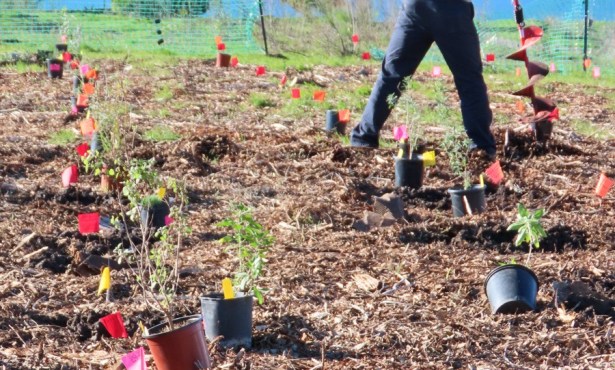Lake Los Carneros
A Great Place for a Quiet Walk
WALK INFORMATION
Distance – .5 to 1.5 miles
Topo – Goleta
Difficulty – Easy
HIGHLIGHTS
The stroll around the lake provides a wonderful early morning or afternoon walk. The lake and mountain backdrop make you feel like you are out in the country. This is a great place to watch birds, including many varieties of ducks thagt migrate here in the winter. The historic Goleta Depot and Stow House are nearby, where you can find out more about Goleta Valley History.
DIRECTIONS
From Santa Barbara drive northbound on Highway 101 to the Los Carneros exit in Goleta. Turn right and drive 0.4 miles north to the parking lot for Stow House and the South Coast Railroad Museum. Follow the paved path past Stow House to the trails that lead around the lake.
SETTING THE SCENE
In the summer of 1871, William Whitney Stow, a former speaker of the California state assembly, visited the Goleta Valley. He was looking for farming property for his son, Sherman Stow. Colonel W.W. Hollister entertained the well-known politician at his Glen Annie home and during the visit suggested Stow consider purchasing the nearby La Patera Ranch, which he did in July, 1871.
One of the most important landmarks included on the property was the original duck pond – or la patera. This small body of water was called Stow Lake or Stow Pond by the owners but the Spanish word quickly became attached to the name of the ranching enterprise, and hereafter it was known as La Patera Ranch.
After securing water rights in the upper canyon through what was most likely a bit of dubious lobbying, the Stow family began building its agricultural fortunes. The first crop planted was tobacco, which failed due both to grasshoppers and a climate which was too mellow to produce good quality leaves.
However, in the spring of 1974, Sherman Stow planted the first of several thousand lemon trees on thirty acres of rolling foothills, which had been cleared of the once-predominant oak trees by hard-working ranch crews. The orchards and valley lemon industry continued to prosper under the management of Sherman’s younger brother, Edgar, who cleared even more land using the first tractors seen in the Goleta Valley.
Edgar Stow also developed an extensive irrigation system by raising the dam on Stow Lake to impound more water and building three other permanent reservoirs on the property. T assuring both an adequate supply of water for the orchards, which comprised nearly 300 acres now, as well as the survival of the original patera, so that it might become what is today – one of the hidden jewels of the Goleta Valley.
Much of what was the historic La Patera Ranch is now part of the public park system. In 1964, the Stow company deeded Stow Grove to the county as a public park and in 1967, when the county acquired an additional three acres around the Stow House, the heirs donated the two-story house, thus creating the initial parts of what would become the park which is now known simply as “Lake Los Carneros.”
The balance of the 136 acres of the park was purchased in 1975 from Boise Cascade with $1.25 million of state money. Initially, the county had plans to construct baseball fields and other developed facilities, but neighbors protested. “Leave it the way it is,” they said. “It doesn’t need any improvement.” Fortunately, the county heeded this wise advice.
THE HIKE
From the parking lot, there are a number of options. The historic Goleta Depot is nearby and it is well worth visiting as well as the Stow House, if you are interested in learning more about the history of the Goleta Valley. The Depot Store is open Wednesday-Sunday from 1-4 PM throughout the year. If you would like more information about the Depot you can find it at the South Coast Railroad Museum web site (http://www.goletadepot.org/).
For me, however, the main attraction is Lake Los Carneros. This is a beautiful place for a relaxed walk and the views from the benches located on the south side of the lake are wonderful. You can head in either direction.
To walk around the lake in a clockwise direction, look for a side trail on the left side of the road just after you pass Stow House. The trail is unmarked and narrow but it lead to a very pretty wooden bridge and across the upper inlet, the main water source for Lake Los Carneros. You will discover beautiful views along this section through the cattail and tule reeds into the upper lake. Often you can stand on the bridge and spot different types of ducks, egrets and other birds right below you as they search of morsels of food. After you cross the bridge the trail begins to rise up onto the surrounding open space. If you want to continue along the edge of the lake turn right on the first path and follow this.
Most people head off to the right for the walk around the lower part of the reservoir. There are benches along the way to sit and watch the birds and enjoy the mountain views. Usually there are plenty of ducks and often geese along the southern part of the lake. As you continue around the lower part of the lake you’ll eventually reach a network of trails leading around and along the eastern side of Lake Los Carneros. The paths seem to meander here and there rather than heading in any specific direction and there are routes down through the eucalyptus trees to the water’s edge and out in the open meadows. This is a very peaceful part of the park and the trees very pretty to walk in and out of. You’ll know Stow House is just around the corner as cross over the last bluff and drop down across the wooden bridge marking the upper inlet.



